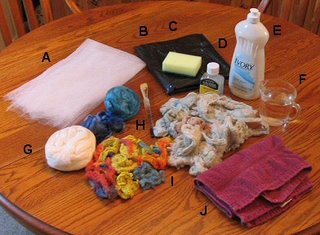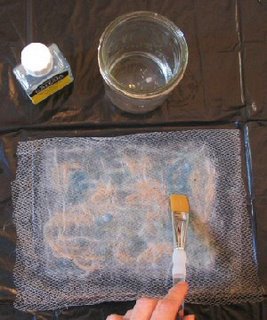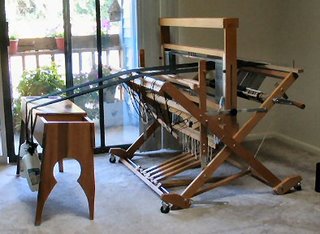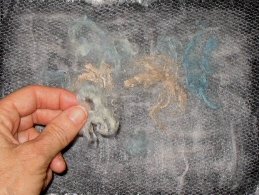When I read
this blog
the other day, I remembered my
silk goody pack. I was inspired to go get it out and look through it once more. I also pulled
out some dyed silk noils sent to me by my friend Heather, who lives in
Manitoba.
Heather does quite a bit of felting and fusion. A while ago
she had shared some information with the
Online Guild
about silk fusion. I had saved a copy of her instructions on my hard drive, so I
printed them out and gathered up my supplies:

A - netting, B - plastic to cover my work surface, C - sponge for soaking up
excess water, D - acrylic gloss medium, E - dishwashing liquid, F - cup of
warm water, G - various silk tops, H - small, soft artist's brush, I - variety
of hand dyed silk noils, J - towel for hands, drips, whatever.
The
first step was to cut a piece of netting twice as large as the piece I was
going to make. The silk tops were drawn out to create two thin layers, the 2nd
perpendicular to the first:

The netting was folded over and the entire thing wetted thoroughly with a
dilution of 1 teaspoon dishwashing liquid in 1 cup of warm water.
When thoroughly wet, the netting was lifted so that embellishments could be
added. Here I added some of the pastel silk noils:
After embellishing, the netting is folded over once again and the entire
thing rewetted. The sponge was used to mop up if I used too much water.
Next, a 50/50 mixture of acrylic gloss with water was brushed over the
entire thing.

Ideally, I should have had a drying rack or screen to place this on but I
didn't. I set it aside on a clean, dry towel and turned it occasionally.
I
had more of my acrylic mixture left, so I experimented:

Left: I used my blue silk tops and embellished with some leftover
throwsters waste
which I had dyed.
Middle: Blue silk tops as a base embellished with silk noils.
Right: This
one is of silk noils entirely. I teased them out to make several layers.
I
allowed them all to dry overnight.
The next morning I carefully
peeled the netting off:

Here are my finished results:

I put the complete set of my silk fusion project photos on my
Flickr Photos.
At this point I have no plans for my masterpieces, except to
keep as samples or perhaps use as insets in greeting cards. I can see where I
made some places too thin and some too thick. There are some areas which could
have used more the the acrylic mixture, but even so I am happy with them.
These
were all quite spontaneous but I can see the potential for more thoughtful
designing. If you want to see some beautiful silk fusion and projects made
with it, spend some time exploring
Sue B's blog.
Her's are inspirational!
 When I used to warp front to back, I would hand tension my warp. After
my first b2f warp, I decided to try using weights instead. When I did, I discovered that my warp
tension was more even and weaving was more enjoyable.
When I used to warp front to back, I would hand tension my warp. After
my first b2f warp, I decided to try using weights instead. When I did, I discovered that my warp
tension was more even and weaving was more enjoyable.







































